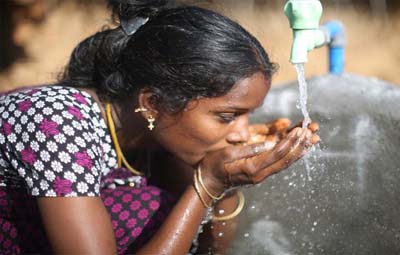Water key to sustainable development
Manzurul Alam Mukul || risingbd.com

Manzurul Alam Mukul: A drop of water is flexible. A drop of water is powerful. A drop of water is in demand. Water is at the core of sustainable development. Water resources underpin poverty reduction, economic growth and environmental sustainability. From food and energy security to human and environmental health, water contributes to improvements in social well-being and inclusive growth, affecting the livelihoods of billions.
According to UNICEF, access to drinking water has been one of the biggest challenges to the Millennium Development Goals.
Today 748 million people around the world still have no clean water to drink. Global water resources may soon meet only 60% of the world’s water demands, the United Nations warns in a dire new report. The World Water Development Report issued ahead of World Water Day, says demand for water around the world will increase by 55% over the next 15 years.
For children, lack of access to safe water can be tragic. On average, nearly 1,000 of them die every day from diarrhoeal diseases linked to unsafe drinking water, poor sanitation, or poor hygiene, UNICEF says.
For women and girls, collecting water cuts into time they can spend caring for families and studying. In insecure areas, it also puts them at risk of violence and attack. UNICEF estimates that in Africa alone, people spend 40 billion hours every year just walking to collect water.
The relationship between water and development is particularly critical in the Asia-Pacific region, one of the most water-stressed regions in the world, and home to 61 percent of the world’s people, with a population expected to reach five billion by 2050.
While South Asia supports more than 21 percent of the world’s population, it has access to just over eight percent of global water resources, with per capita water availability decreasing by nearly 80 percent since the 1950s.
South Asia, home to the Brahmaputra, Indus, and Ganges, has numerous bilateral treaties, agreements, and joint commissions that regulate the use and management of shared rivers between Bangladesh, India, Nepal, and Pakistan. But the countries are failing to share the water properly.
According to a study, a city’s ability to provide water services is an important indicator of its `greenness.` However, many of Asia’s poorer cities are not able to provide wide-reaching, consistent water services.
Bangladesh is one of the most densely populated countries in the world with huge population living below the poverty line. Those living in slums on the outskirts of Dhaka have no rights to the land on which they live and are denied personal water connections. Consequently, 24% of deaths can be attributed to water related diseases – the majority of which kill children under the age of five.
As Bangladesh is observing the World Water Day today, it still has nearly 28 million people without access to safe drinking water, sources say.
Bangladesh is also ranked seventh among 10 worst water crisis-hit countries, according to UNICEF and the World Health Organisation (WHO).
According to a study, Bangladesh women have to spend 20 crore working hours per day to collect water for family purpose. The government loses US$ 80 crore per year due to scarcity of pure water and sanitation.
Most of the people without access to these services are living in hard-to-reach areas like chars, haors, exposed coastal areas, hills, flood and extreme drought zones.
There is also high child mortality rate in the inaccessible areas due to lack of safe water, sanitation and hygiene. Water price varies from area to area. People living in coastal areas have to pay more prices to buy water than the Dhaka city residents, according to a study.
It is learnt that salinity intrusion into the aquifers of the country’s coastal districts has reached an alarming proportion due to unplanned use of groundwater in agriculture and seawater seeping into underground due to sea-level rise caused by global warming.
It is found that salinity intrusion has gripped some coastal districts since there is no freshwater layer up to the depth of 1,100 feet. There’s no freshwater layer up to 1,100 feet deep in Barguna, Pirojpur, Gopalganj and Satkhira…freshwater may be found 1,300-1,400 feet deep the ground.
The hydrologist says water layer is found up to only 300 feet deep the aquifer in Satkhira, but the layer is full of saline water.
Salinity is also increasing gradually in the surface water of the coastal rivers. The agriculture is facing trouble due to salinity rise in river water, decreasing the food grain production.
Approximately 30 million people are exposed to drinking arsenic contaminate water and 90% of those living in the rural areas.
As per WHO guidelines, 10 microgram of arsenic per liter can be acceptable, but in Bangladesh it is 50 microgram per liter, leading to chronic arsenic poisoning.
Scarcity of safe water is seriously hampering maternal health. In Bangladesh, 10% populations are persons with disabilities. Most of them have no access to appropriate water and sanitation facilities, says a report.
Huge portions of about 700 rivers and tributaries, 98,000 hectares of inland water bodies and over 24,000 streams are being dried out or been filled up by human activities.
On the other hand, surface water is usually being polluted due to human activities. All kinds of industrial waste of urban areas are dumped into the city-side rivers around the country.
World Water Day is marked on 22 March every year. It’s a day to celebrate water and to prepare for how we will manage water in the future. In 1993, the United Nations General Assembly designated 22 March as the first World Water Day.
Each year, World Water Day highlights a specific aspect of freshwater. World Water Day-2015 is being observed with the theme `Water and Sustainable Development`.
The theme provides an important opportunity to consolidate and build upon the previous World Water Days to highlight water`s role in the sustainable development agenda.
The UN has shaped a Sustainable Development Goals framework based on the global experience on achievements of MDGs. Ensuring availability and sustainable management of fresh water is a major goal to achieve.
Thus, Bangladesh as a developing country must identify the nexus between water and sustainable development to achieve the goal of MDGs considering its indicators.
In this relation, major components under the theme of this year’s World Water Day, Water is Health; Water is Nature; Water is Industrialization; Water is Urbanization; Water is Food; Water is Energy and Water is Equality need to be analyzed.
It is imperative that all nations and stakeholders rise to the collective challenge of using water sustainably. Anything less will imperil our ability to feed the planet and provide clean drinking water for all, not only today, but as the world’s population rises to more than 9 billion by 2050.
Water is inseparable part of agriculture, industry, food and energy sectors, overall public health and socio-economic development, so water should be used in the country’s development process in a planned way.
risingbd/March 2015/Mukul
risingbd.com





































